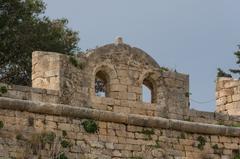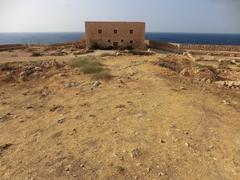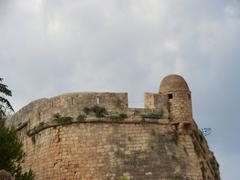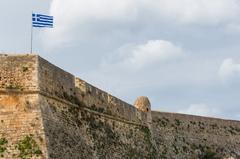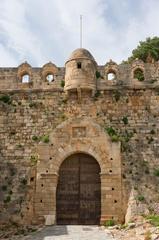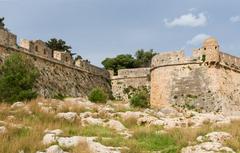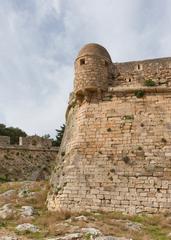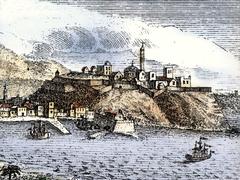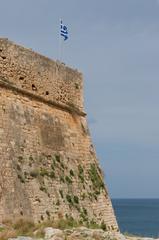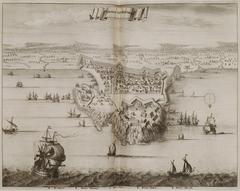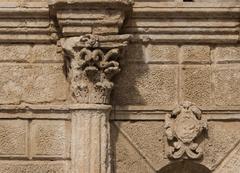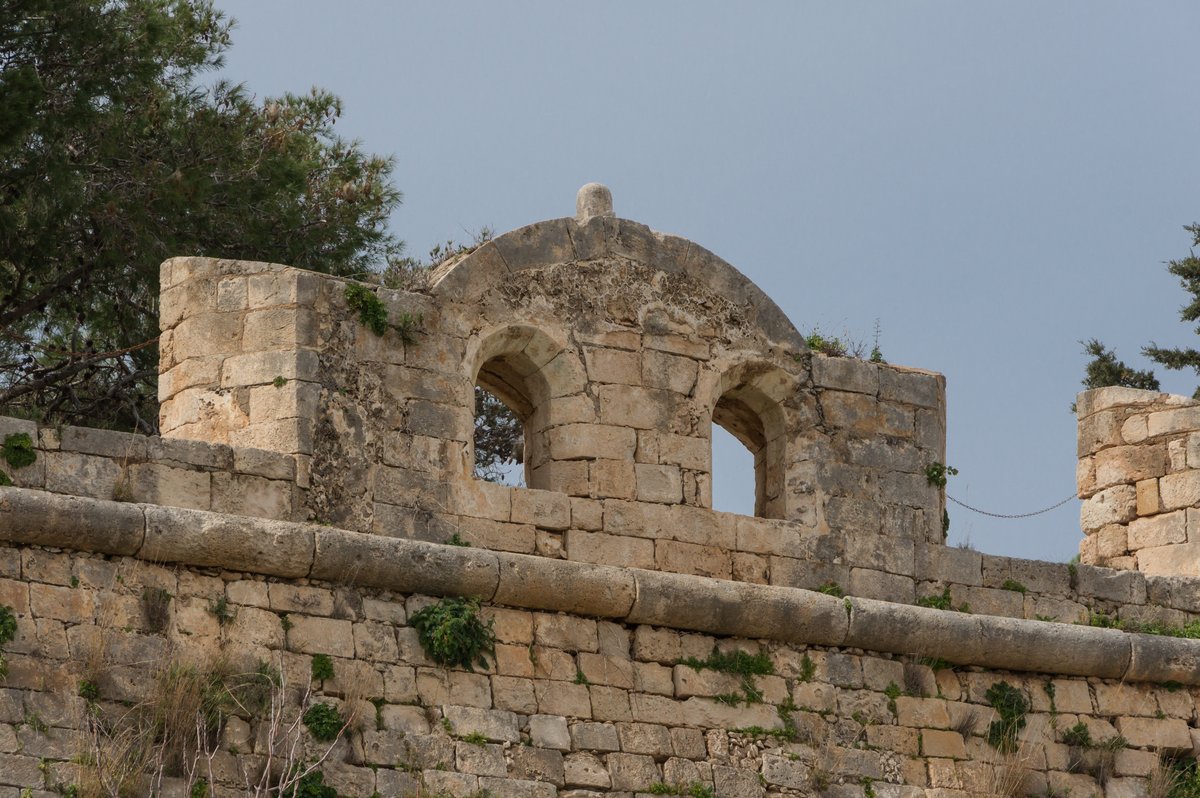
Visiting Hours, Tickets, and Historical Insights of Fortezza of Rethymno
Date: 16/08/2024
Introduction
The Fortezza of Rethymno stands as a commanding fortress atop Paleokastro Hill in Rethymno, Crete, Greece. Built by the Venetians between 1573 and 1580 to defend against the Ottoman threat after the fall of Cyprus in 1571, the Fortezza is a landmark of resilience and a testament to the city’s layered history (source, source). The site has deep roots, once sheltering the acropolis of ancient Rhithymna and a sanctuary to Artemis Rokkaia (source). Over time, it has seen Venetian and Ottoman modifications and, in the modern era, become a vibrant cultural hub that hosts events such as the Rethymnon Renaissance Festival (source, source). Today, the fortress draws visitors for its architectural grandeur, panoramic city and sea views, and rich narrative.
Contents
- Historical Background
- Visitor Information
- Cultural Significance
- Architectural Features and Layout
- Nearby Attractions
- FAQ
- Architectural Highlights
- Visitor Tips
- Practical Information
- Ultimate Visitor’s Guide
- Summary and Key Points
- Reliable Sources and Further Reading
Historical Background
Ancient and Byzantine Foundations
Paleokastro Hill, the present site of the Fortezza, has been significant since antiquity. It was once the acropolis of ancient Rhithymna, including a sanctuary dedicated to Artemis Rokkaia (source). In the Byzantine era (10th–13th centuries), a fortified settlement known as Castrum Rethemi was established east of the hill, with square towers and dual gates. Enrico Pescatore later restored these walls in the early 13th century (source).
Venetian Rule and Construction
When Crete came under Venetian control, Rethymno rose in prominence. The Venetians built a harbor and, in 1540, started fortifying the city under architect Michele Sanmicheli. After a devastating Ottoman attack in 1571 exposed their defenses, the Venetians initiated the construction of the Fortezza in 1573, directed by rector Alvise Lando and master builder Giannis Skordilis, based on plans by Sforza Pallavicini. The massive project required 76,800 days of forced labor from local residents (source). The star-shaped fortress, with three gates and four bastions, exemplifies the Italian bastioned system (source).
Ottoman Conquest and Modifications
Despite its formidable design, the Fortezza succumbed to the Ottomans in 1646 during the Fifth Ottoman–Venetian War. Overcrowding, disease, and dwindling supplies forced the Venetian surrender (source). The Ottomans made only minor structural changes, such as building a ravelin outside the main gate and converting the cathedral into a mosque. Administrative and garrison housing was added, but the fortress’s overall design remained intact (source).
Visitor Information
Visiting Hours and Tickets
- Opening Hours: The Fortezza is open daily. Standard hours are from 10:00 AM to 6:00 PM, with last admission at 5:15 PM. During summer, hours may extend (8:00 AM–8:00 PM in peak season; 8:00 AM–5:00 PM in low season) (source, source).
- Tickets: The general admission fee is €4. Family tickets are available for €10, seniors (over 65) pay €3, and students enter free (source).
For the latest opening hours and ticket prices, consult the official website or local tourist information.
Travel Tips and Accessibility
- Allow at least two hours to explore the grounds, especially if you wish to visit the bastions, ramparts, and underground vaults.
- Access: The fortress is a short uphill walk from Rethymno’s old town. Limited parking is available nearby, but walking from the city center is often more convenient (source).
- Facilities: On-site kiosks sell drinks/snacks. Restrooms are available for a small fee.
Cultural Significance
The Fortezza is more than a military relic; it is a vibrant cultural venue. The open-air Theatre of Erofili, named after Cretan playwright Georgios Chortatsis’s famous work, hosts the annual Rethymnon Renaissance Festival, as well as other concerts and events inspired by the Renaissance (source). This blend of history and contemporary culture makes the site a living symbol of Rethymno’s identity (source).
Architectural Features and Layout
- Shape: The Fortezza has an irregular polygonal design with four bastions and three gates, and walls stretching 1,307 meters (source).
- Italian Bastioned System: Its fortifications reflect state-of-the-art Venetian military architecture (source).
- Notable Structures: Ibrahim Han Mosque (formerly a church), bastions such as Santa Maria, and the Theatre of Erofili.
Nearby Attractions
- Archaeological Museum of Rethymno: Housed in the Ottoman ravelin near the fortress.
- Rethymno Old Town: A maze of Venetian and Ottoman-era streets, shops, and cafes.
- Venetian Harbor and Rimondi Fountain: Picturesque landmarks within easy reach (source, source, source).
FAQ
What are the visiting hours for the Fortezza of Rethymno?
Open daily, typically 10:00 AM–6:00 PM; check local resources for seasonal variations.
How much are tickets?
General admission is €4; family, senior, and student discounts available.
Is the Fortezza accessible?
Yes, it is accessible on foot from the old town; guided tours and informational brochures are available.
What is the best time to visit?
Early morning or late afternoon (spring and autumn) for favorable weather and fewer crowds.
Are there cultural events?
Yes, especially the Renaissance Festival and performances at the Theatre of Erofili.
Architectural Highlights
Bastions and Ramparts
The bastions and ramparts, designed for maximum defense, offer panoramic views of Rethymno and the sea. Walking the ramparts provides both historical context and scenic beauty (source).
Central Citadel
At the core of the fortress is the citadel, the administrative and military heart. Visitors can explore remnants of storage, living quarters, and command posts (source).
Sultan Bin Ibrahim Mosque
Originally the cathedral of Saint Nicholas, it was converted into a mosque under Ottoman rule. Today, the building is notable for its large dome, mihrab, and mosaic ceiling, and sometimes hosts musical events (source).
Visitor Tips
- Best Time to Visit: Spring or autumn for mild weather. Early morning or late afternoon for sunset and cooler temperatures (source).
- Exploring the Grounds: Allocate at least two hours; wear comfortable shoes due to uneven terrain (source).
- Stay Hydrated: Bring water, especially in summer, and use sun protection.
Practical Information
- Getting There: Accessible from Chania and Heraklion airports by bus or car. The city center and main attractions are walkable (source).
- Dining and Shopping: The Old Town offers Cretan cuisine, cafes, and shops selling local products like olive oil and honey (source).
Ultimate Visitor’s Guide to Fortezza of Rethymno
Getting There
Travelers can reach Rethymno via Chania or Heraklion airports, with frequent bus connections (1–1.5 hours). Ferries from Athens Piraeus port arrive in both cities (source).
Entrance Fees and Opening Hours
€4 for adults, €10 for families, €3 for seniors, and free for students. Open 10:00 AM–6:00 PM, last entry 5:15 PM (source, source).
What to See Inside
- Ibrahim Han Mosque: Impressive dome and mosaics (source).
- Bastion of Santa Maria: Excellent vantage point.
- Theatre of Erofili: Venue for cultural events (source).
- St. Catherine’s Church: Adds to the historic atmosphere (source).
Guided and Virtual Tours
Guided tours are available for deeper insight. A virtual tour is also accessible online (source).
Amenities
Kiosk for refreshments; restrooms available for 50 cents (source).
Photography Tips
Best light is in the early morning or late afternoon. Sunset shots from the western ramparts are especially dramatic (source).
Safety Tips
Take care on uneven surfaces and steps. Bring water, wear a hat, and protect belongings.
Summary and Key Points
The Fortezza of Rethymno encapsulates the city’s rich heritage, from its ancient origins to its role in Venetian and Ottoman conflicts (source, source). Its imposing architecture, cultural events, and sweeping views make it an essential destination for visitors. With practical tips and historical context, travelers can make the most of their experience. Stay updated through the Audiala app and authoritative travel guides (source, source).
